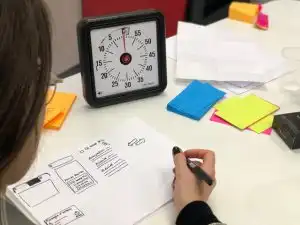Last week, I wrote a post about the importance of taking a break. It’s not the first time I’ve noted the importance of this practice. I’ve recommended breaks to address stress, prevent burnout, deal with Zoom fatigue, and generally plan for productivity. Breaking up the work day benefits your health and your productivity, especially during this pandemic. The trouble lies in implementing those breaks.
For remote workers in particular, it may seem challenging to know when and how to take that break. I highlighted the longer workday COVID-19 has created last week, but it’s also important to note the disappearance of time off. Employees have stopped taking vacations. That’s the critical issue this HBR article criticizes and addresses. Lists of productivity strategies for pandemic-forced remote workers like this one from Forbes highly encourage breaks. However, it seems we don’t quite know how to break up the monotony of work in COVID-19 times. Here are some tips to get you started.
Plan for Breaks In Advance
I’m first to admit I’ve fallen into that trap of telling myself, “I’ll take a break when I finish this.” Next thing you know, you’re working on the fifth task since then, feeling more behind than ever. If you don’t set a strict expectation in advance for yourself, you’ll avoid breaks because they just don’t feel productive. However, as a participant in this study noted, we recognize how much we need a break after we’ve taken it.
Setting yourself up for success can take a few forms. In this Forbes article by career coach Dina Denham Smith, she recommends scheduling breaks into the calendar. One tip she highlights involves setting meetings to start 10 minutes past the hour. It’s more likely you’ll take a break at the top of the hour and then focus better on your shorter meeting than successfully end 10 minutes early. Denham Smith also suggests including planned breaks in longer meeting agendas.
Time management expert and author Laura Vanderkam, cited in this article from MIT, supports planning ahead proactively. On top of that, though, she recognizes the potential of spontaneity. Vanderkam encourages employees to keep an eye out for found time. That might be a canceled meeting or a task you finished faster than expected. Either way, seize the moment. Before jumping into your next task, take advantage of the time and take a break.
But When?
If you’re sitting down to schedule your breaks, you may be wondering when to plan them. Fortunately, there’s a whole slew of suggestions from the experts. One study from Baylor University’s Hankamer School of Business found that the best time for breaks is mid-morning, before you’re totally drained. They also advised taking breaks frequently, even if for less time.

How frequently? Well, there’s lots of debate on that question. According to Bob Pozen, senior lecturer at MIT and author, you should take a break every 75-90 minutes. This article cites research that advocates for more frequent breaks. Their recommendation is for a 17-minute break after every 52-minute stretch of work. That’s based on a study of the most productive workers. The Pomodoro technique promotes even more frequent breaks! Check out this video for their recommendations to make the most of 25-minute work periods.
Of course, a personalized schedule may serve you better than a rigid schedule based on 90-, 52-, or 25-minute blocks. This study successfully monitored employees’ affect and productivity in order to deliver personal recommendations for break times over several days. On average, their model suggested 6-7 breaks per day. As it turns out, employees liked the personalized timing! They rated the model’s nudges to take a break as 77% spot-on. So if none of those scheduled systems seems like it’s working, try tracking your own mood and productivity. When you think you need a break, take it.
The Best Breaks
Research has demonstrated that as little as 5 minutes can boost your mental wellness. It matters, though, how you spend them. That study found that five minutes spent specifically in nature made the real impact. Indeed, this impassioned HBR article advocates taking breaks outdoors during the workday for the myriad benefits. Time outdoors can benefit your physical health, psychological wellness, cognitive abilities, creativity, and social interactions.

That’s not the only way to take advantage of a break, though. This article proposed “booster breaks” to boost both wellness and productivity at once. This follow up article described the practices these can involve. For example, physical activity, meditation, or even breathing exercises all qualify as “booster break” practices. This Forbes article about lunch breaks concurs with the recommendation for exercise, but it also adds some other options.
Especially in COVID-19 times and in the winter, getting outdoors or finding space to work out may be tough. You can also use break time to eat a healthy snack, or connect with a loved one. Think of those in your home and on your phone. Another idea is taking quiet time, as long as it’s not online. Reading a book for 15 minutes may be just what you need to refocus and re-energize.
Leading the Way to Time Off
That same Forbes article not only lists strategies for employees, but also for their workplace leaders. If you manage a team or lead a division, you can set the tone for your (virtual) workplace. Talking about the benefits of breaks with your employees in meetings and emails can help encourage the practice more. Of course, it’s also important to lead by example. This HBR article picks up on that tip.
It also focuses the need for leadership to encourage breaks in general on a crisis of COVID-19 times. As travel slows and “getting away” becomes inaccessible or risky for many, the need for time off remains. Leaders can make a difference for their employees by taking time off themselves and encouraging employees to re-envision this term for themselves. Time off doesn’t need to mean a vacation or a long chunk of time. It may just mean taking a half-day once a week to focus on family or caregiving responsibilities. Workplace leaders can share these options with employees and let them know that time off remains available for them.
In particular, as I emphasized in my blogs on women in the workplace, leaders play a critical role in support working women. Encouraging women and others with caregiving responsibilities on your team to take the time they need matters. Teams can collaborate to fill in for one another. Most of all, we can boost our empathy, for ourselves, our team mates, and our employees.
I’ve inspired myself to track my own time and breaks better after this mini-series. Don’t mind me! I’m just stepping away for a quick break outdoors.